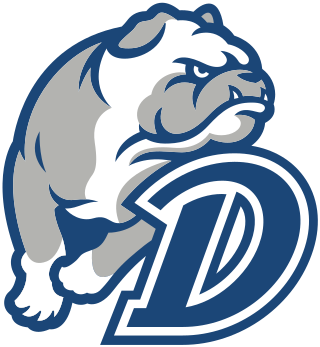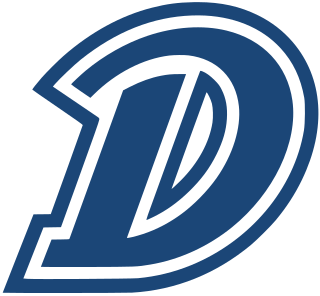
Drake University is a private university in Des Moines, Iowa, United States. The University offers over 140 undergraduate and graduate programs, including professional programs in Business, Education, Law, and Pharmacy. Drake's Law School was founded in 1865, which makes it one of the 25 oldest law schools in the United States.

The Drake Bulldogs are the intercollegiate athletics teams that represent Drake University, located in Des Moines, Iowa, United States. The Bulldogs' athletic program is a member of the Missouri Valley Conference (MVC) and competes at the NCAA Division I level. Drake also sponsors teams in the Pioneer Football League, Metro Atlantic Athletic Conference, and Summit League. Drake's live bulldog mascot is Griff II; the costumed mascot is Spike; and the school colors are blue and white.

John Dee Bright was an American professional football player in the Canadian Football League (CFL). He played college football for the Drake Bulldogs. He is a member of the Canadian Football Hall of Fame, the College Football Hall of Fame, the Missouri Valley Conference Hall of Fame, the Edmonton Eskimos Wall of Honour, the Alberta Sports Hall of Fame, and the Des Moines Register's Iowa Sports Hall of Fame.
Jennings Bryan "Ears" Whitworth was an American football player and coach of football and baseball. He served as the head football coach at Oklahoma Agricultural and Mechanical College—now known as Oklahoma State University–Stillwater—from 1950 to 1954 and the University of Alabama from 1955 to 1957, compiling a career college football coaching record of 26–51–4. Whitworth also coached baseball at Alabama from 1933 to 1934 and the University of Georgia in 1943, tallying a career college baseball coaching mark of 22–21.

The Drake Bulldogs men's basketball team represents Drake University, located in Des Moines, Iowa, in NCAA Division I basketball competition and is coached by Darian DeVries. The program is best known for making the 1969 Final Four. The Bulldogs have appeared seven times in the NCAA tournament, making their most recent appearance in 2024.
The 1951 college football season finished with seven unbeaten major college teams, of which five were unbeaten and untied. Ultimately, the Tennessee Volunteers were voted the best team by the Associated Press, followed by the Michigan State Spartans, with the Vols having a plurality of first place votes. Tennessee lost in the Sugar Bowl to the equally undefeated and untied No. 3 Maryland Terrapins, but the postseason games were not taken into account by the major polls. Tennessee, Michigan State, and Illinois all claim national championships for 1951.
Donald Theodore Ultang was an American photographer, a pioneer in aerial photography and a Pulitzer Prize winner.

The Drake Bulldogs are an NCAA Division I Football Championship Subdivision non-scholarship college football program representing Drake University. They currently compete in the non-scholarship Pioneer Football League and have been charter members of the conference since 1993. Drake began playing intercollegiate football in 1893.

This is a page on the history of Missouri Valley Conference football. The Missouri Valley Conference sponsored football from 1907 through the 1985 school year. The conference voted to drop football as a sport on April 30, 1985. At the time the Conference was a mixture of NCAA division I-A programs and NCAA division I-AA programs.
The 1922 Drake Bulldogs football team was an American football team that represented Drake University as a member of the Missouri Valley Conference (MVC) during the 1922 college football season. In its second season under head coach Ossie Solem, the team compiled a 7–0 record, tied with Nebraska for the MVC championship, and outscored opponents by a total of 155 to 26.
The 1928 Drake Bulldogs football team was an American football represented Drake University in the Missouri Valley Conference (MVC) during the 1928 college football season. In its eighth season under head coach Ossie Solem, the team compiled a 7–1 record, won the MVC championship, and outscored all opponents by a total of 141 to 52. The team's only loss was against Knute Rockne's Notre Dame Fighting Irish.
The 1924 Drake Bulldogs football team was an American football team that represented Drake University as a member of the Missouri Valley Conference (MVC) during the 1924 college football season. In its fourth season under head coach Ossie Solem, the team compiled a 5–2–1 record, placed third in the MVC, and outscored its opponents by a total of 106 to 56.
The 1929 Drake Bulldogs football team was an American football team that represented Drake University in the Missouri Valley Conference (MVC) during the 1929 college football season. In its ninth season under head coach Ossie Solem, the team compiled a 5–3–1 record, won the MVC championship, and outscored all opponents by a total of 145 to 79.
The 1923 Drake Bulldogs football team was an American football team that represented Drake University as a member of the Missouri Valley Conference (MVC) during the 1923 college football season. In its third season under head coach Ossie Solem, the team compiled a 5–2 record, placed third in the MVC, and outscored its opponents by a total of 168 to 49.
The 1925 Iowa State Cyclones football team was an American football team that represented Iowa State College of Agricultural and Mechanic Arts in the Missouri Valley Conference (MVC) during the 1925 college football season. In its fourth and final season under head coach Sam Willaman, the team compiled a 4–3–1 record, tied for third place in the conference, and outscored opponents by a total of 107 to 93.
The 1920 Drake Bulldogs football team was an American football team that represented Drake University as a member of the Missouri Valley Conference (MVC) during the 1920 college football season. In its third and final season under head coach M. B. Banks, the team compiled a 4–5–1 record, finished fifth in the conference, and outscored opponents by a total of 149 to 40.
The 1949 Drake Bulldogs football team was an American football team that represented Drake University as a member of the Missouri Valley Conference during the 1949 college football season. In its first season under head coach Warren Gaer, the team compiled a 6–2–1 record, finished second in the conference, and outscored opponents by a total of 202 to 95. The team played its home games at Drake Stadium in Des Moines, Iowa.
The 1950 Drake Bulldogs football team was an American football team that represented Drake University as a member of the Missouri Valley Conference during the 1950 college football season. In its second season under head coach Warren Gaer, the team compiled a 6–2–1 record, tied for fourth place in the conference, and outscored opponents by a total of 247 to 117. The team played its home games at Drake Stadium in Des Moines, Iowa.
The 1951 Drake Bulldogs football team was an American football team that represented Drake University as a member of the Missouri Valley Conference during the 1951 college football season. In its third season under head coach Warren Gaer, the team compiled a 7–2 record, tied for fourth place in the conference, and outscored opponents by a total of 247 to 117. The team was ranked at No. 80 in the 1951 Litkenhous Ratings.
The 1951 Bradley Braves football team was an American football team that represented Bradley University as a member of the Missouri Valley Conference (MVC) during the 1951 college football season. Led by first-year head coach Bus Mertes, the Braves compiled an overall record of 4–5 with a mark of 0–3 in conference play, placing last out of seven teams in the MVC.








